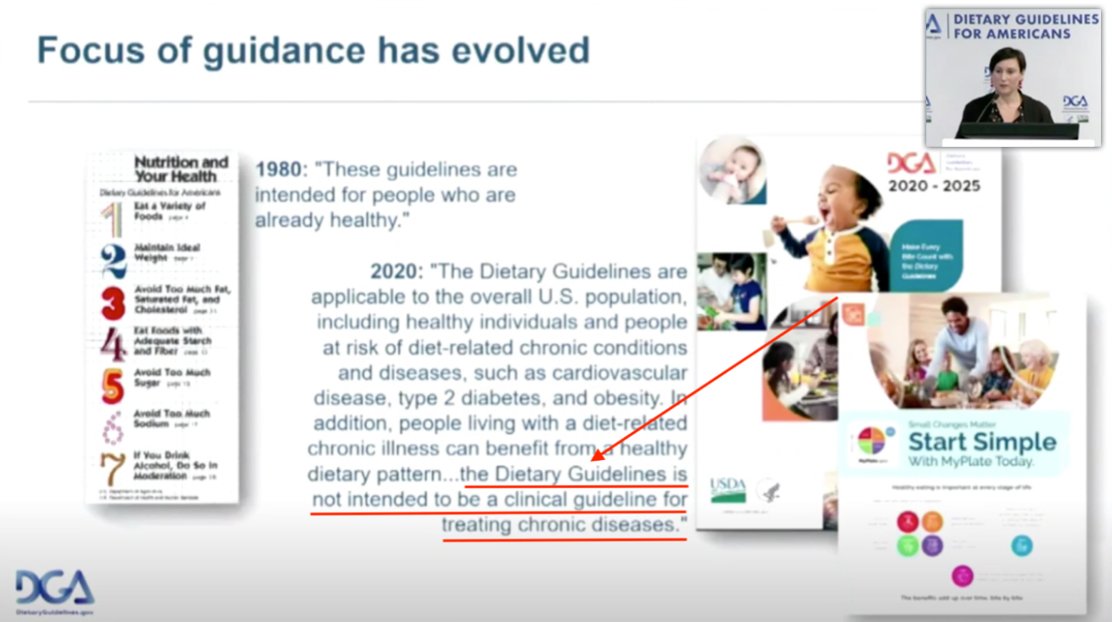

For the past 45 years (since 1980), the federal government has been publishing the Dietary Guidelines for Americans —the principal policy guiding diet in the United States—with three goals, to:
1. promote good health,
2. help Americans reach a healthy weight, and
3. prevent chronic disease.
However, by any measure, the guidelines have failed to achieve these goals.

Why have the guidelines not helped Americans protect their health? See these recommendations:
All grains and sugars are carbohydrates, which break down in the body as sugar (glucose). Glucose causes your blood sugar to spike. This happens even after eating whole grains, potatoes, or fruit. The spikes are usually higher with refined carbohydrates, like white bread and sweets.
Eating a lot of carbohydrates—every day and many times a day—forces your body constantly to deal with these spiking blood sugars by secreting insulin from the pancreas. Over time, body tissue can no longer handle so much insulin, leading to “insulin resistance,” which is the root cause of chronic diseases. Therefore, the guidelines should stop advising Americans to eat >50% of our calories a day as carbohydrates.

In 1965, the obesity rate for US adults was under 15% for adults. Now it’s nearly 43%.
Americans in the 1940s
Photo credit: Princeville Heritage Museum
By telling us to eat so many grains and sugars, the guidelines have very likely increased the risk of chronic disease or possibly even caused these epidemics.
This idea is supported by the fact that a very large body of rigorous science now shows that type 2 diabetes and obesity, among other diseases, can be reversed by eating a diet low in carbohydrates.
The case for type 2 diabetes is especially strong. No other whole-foods approach has the science (i.e. clinical trials) to show that it can reverse this disease—not low-calorie, low-fat, vegan/vegetarian, Mediterranean, DASH or any other diet. Only a low-carbohydrate diet is backed by a high level of scientific evidence.

The 2020 Dietary Guidelines Expert Report states: “Nutrients that do not meet Recommended Dietary Allowance or Adequate Intake goals include the following: Iron, Vitamin D, Vitamin E, Choline, and Folate."
To get enough iron and folate, the guidelines recommend 3 to 5 servings a day of fortified, refined grains (because only refined grains are enriched and fortified).


The guidelines are taught in schools (K-12) and are considered the “gold standard” by doctors, nutritionists, dieticians and other health professionals.
The guidelines are also required, by law, to be followed by all federal nutrition programs, such as school lunches, SNAP (Supplemental Nutrition Assistance Program), food for women, infants and children (WIC), and programs for the elderly. Also: nutrition programs for the military.

The guidelines does not provide treatment advice for sick people. The policy is designed for prevention only. In 2023, a USDA official admitted this fact:
2025 Dietary Guidelines Advisory Committee, First Meeting: Day 1 of 2, 2/9/2023, (00:34:18)
What does this mean? The process to create the Guidelines does not include a review of the scientific literature on how to reverse obesity, type 2 diabetes or any other chronic disease. For instance, the 2020 Guidelines process excluded the entire scientific literature on weight loss.

However, the best-available evidence does not support this idea
Measured by Food Availability
Measured by Calories
Measured by Consumption of Plants vs. Animal Foods

Two 2017 reports by the National Academies of Sciences, Engineering, and Medicine (NASEM), mandated by Congress with a $1 million allocation.

These reports found that:
The current guidelines’ process for reviewing the science falls short of meeting the “best practices for conducting systematic reviews.”
“The methodological approaches to evaluating the scientific evidence require increased rigor to better meet current standards of practice.”
“To develop a trustworthy DGA [dietary guidelines], the process needs to be redesigned.”
NASEM made 11 recommendations to USDA, to improve the rigor and transparency of the guidelines process.
Yet the USDA has not fully implemented even one of the NASEM recommendations.
More on these reports is available here.

95% of the expert committee responsible for the science in our current guidelines had at least one tie with a food or pharmaceutical company.
A total of 700+ conflicts of interest were found on the committee.
One advisor alone accounted for 152 of these ties.
The corporations with the most frequent and durable connections to the committee were Kellogg, Abbott, Kraft, Mead Johnson, General Mills, and Dannon.
For more on this paper and conflicts of interest listed by name, see this.
––––––––––––––––––––––––––––––––––––––––––––––––––––––––––––
The USDA office that runs the Dietary Guidelines has formal partnerships with more than 100 food companies.

Other advice in the Guidelines that are not backed by rigorous science:
Lean meat and low-fat dairy
Regular meat and dairy are not encouraged due to cap on saturated fat, but this recommendation has now been challenged in at least 2 dozen major review papers over the past 20 years;
“Lower is better” on salt—read our review here;
Consume 5.5 teaspoons of seed oils daily;
Beans, peas and legumes are adequate protein replacements for meat and dairy—read our article here;


































